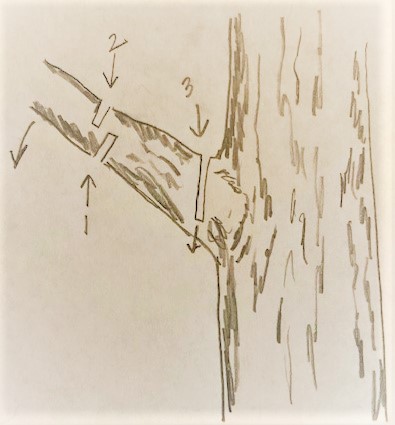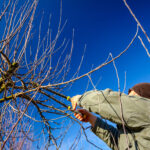Deciduous trees require minimal pruning.
Pruning begins at planting time and continues with regularity for three years or so. Once the form of a tree has been established with initial early pruning, there will be occasional pruning in the years that follow–mostly maintenance pruning to ensure the health and form of the tree.
General guidelines for pruning deciduous trees

• Check the best time to prune the tree. The best time to prune can vary by species. Find the tree in the Index and go to the description for pruning suggestions. As a general rule, deciduous trees are best pruned in late winter or early spring while they are still dormant. The best time to prune most deciduous trees and shrubs is during the dormant period, just before growth begins. Some plants may prove the exception to this rule. In mild winter regions, midwinter is the best time to prune deciduous plants. Trees can be pruned in summer, but the reduction of foliage may diminish the vigor of the plant that year.
• Prune away any dead or diseased wood. Prune away any damaged wood. If there are stubs from previous cuts or broken wood, trim those away. Dead, diseased, or damaged wood can be removed at any time during the year. If left in place, damaged wood can be an entry point for insect, disease, and rot.
• Remove broken branches. Damaged wood or a broken branch is an entry point for insects and disease. Trim it off; trim an inch or so into healthy wood. Make a clean cut and the wound will heal quickly on its own.
• Remove crossing and rubbing branches. Rubbing branches can create wounds and points of entry for pests and diseases. Crossing branches congest the center of the tree. Choose the weakest rubbing or crossing branch and remove it.
• Prune with the shape of the tree in mind. There are four kinds of branches: (1) the leader is the main branch; it points skyward; it is the continuation of the stem or trunk; (2) side branches grow from the trunk are called primary scaffold branches; a tree should have three or four scaffold branches; these give the tree its form; (3) secondary scaffold branches; these grow from the main scaffold branches; (4) lateral branches; these are small branches that from the leader or scaffold branches.
• Select the scaffold branches early in the tree’s life,. Choose large branches that are evenly spaced around the trunk; these branches, for most but not all trees, should be no lower than the top of your head. If you are training a small tree; it will take several years for scaffold branches to grow to the height of your head. Scaffold branches create a strong, balanced tier of limbs at the bottom of the tree’s greenery.
• Remove a secondary leader. A secondary leader is a branch that grows skyward from the main leader, usually at a very close angle to the main leader. A secondary leader will compete with the main leader and distort the tree’s overall shape. Secondary leaders are usually weak and can easily break in a storm.
• Remove suckers. Suckers are branches that form at the base of the tree or grow from the roots. These should be trimmed away as they form. You may be able to grab a sucker and give it a twist to remove it.
• Remove water sprouts. Water sprouts are vertical branches not more than the thickness of a pencil that grows from horizontal limbs. If not trimmed away water sprouts become woody branches; they will grow thick and crowded and detract from the appearance of the tree. Water sprouts when small can be pulled away by hand.
• Remove small limbs and spindly growth that crowds the main limbs. Prune away small limbs with the overall shape of the tree in mind.

How to remove large branches
Cut large branches in stages. First cut off the end of the branch; make additional cuts in sections working your way back to the trunk. When a branch is thick and heavy, prune it away in three steps:
- The first cut is an undercut about a foot from the trunk; saw about a third of the way through the branch.
- The second cut is about an inch further from the trunk; this cut is from the top of the branch down and it removes the bulk of the branch.
- The third cut removes the stub of the branch back to the collar, which is as close to the trunk as possible.
Also of interest:















